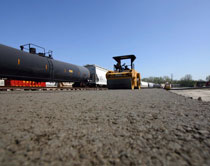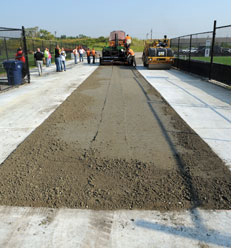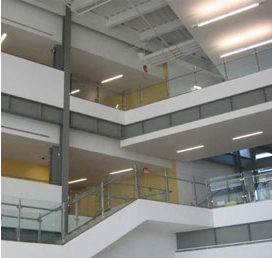
Damage from relentless truck traffic would force the Indiana Rail Road Company to spend way too much time and money maintaining the compacted-aggregate pavement it originally chose for the loading lane at a new intermodal test site.
That’s the view Theron Tobolski of Prairie Material shared with company officials when he asked if they would consider using roller-compacted concrete (RCC) for the project instead.
“We were glad to find that IRRC was open to alternatives,” Tobolski reports. “We felt confident that, when they factored in the cost of dealing with ruts and dips caused by heavy loading activity, they’d see Prairie RCC as the better choice.”
Officials for the Indianapolis-based carrier, which hauls more than 800,000 truckloads of freight annually in southwest Indiana and central Illinois with nationwide connections through Chicago and other cities, reviewed the life cycle analysis, maintenance issues and long-term durability of both pavements. They then opted for RCC – and chose paving contractor K-Five Construction Corp. of Lemont, Illinois to get the job rolling.
Super strength for multi-ton loads

The new plan called for 18 inches of RCC, placed in 6-inch lifts, to replace the 42 inches of compacted aggregate originally specified. The 1,500-foot, 150-foot-wide pavement would run between 2 rail lines, allowing loading of multi-ton containers from either side. A final curing compound would prepare the all-RCC surface for duty.
K-Five crews drew on experience building the RCC pavement supporting a heavy-duty crane at CSX’s intermodal yard on Chicago’s south side and a 7,000-yard placement for the new Central States Trucking terminal in Joliet, Illinois.
“RCC goes down a lot like asphalt but reacts, handles and cures like concrete,” says K-Five Chief Estimator Pat Finn. “Since we have so much experience placing both materials, we can draw on both skill sets.”
Mobile plant speeds mix production
The 3-day construction schedule, along with the unique mix requirements of RCC, meant that Prairie would need a dedicated plant to produce all 6,500 yards needed for the job.
“We brought a ribbon mixer to our Kentucky Avenue plant in Indianapolis to meet the production rates K-Five was looking for,” says Doug Dalton, territory manager for Prairie in Indiana. With the portable plant on site, Prairie was able to produce 8-yard loads in 30-second cycles, he reports.
RCC ‘gives us an advantage’
K-Five crews have learned that moisture and compaction are the tricky parts of handling RCC, says Finn. “It’s such a dry material, but with over time our team has grown confident with it. We’ve had excellent results with standard paving equipment, getting full compaction after two roller passes.”
As one of the largest paving contractors in the region, “we like being able to work with customers any way they want to specify the job,” he says. “RCC adds to our arsenal in a way that gives us a competitive advantage. We’re already in the bid stage for several more RCC jobs this year.”
This latest rail project “was a great chance for Prairie to show Indiana customers the range of industrial paving options we offer,” Doug Dalton says. “We look forward to supplying a growing number of RCC projects throughout our area.”
Discover how RCC is helping cities and towns build better roads at the upcoming American Public Works Association Congress in Chicago, where Prairie’s Theron Tobolski will join Matt Mann, head of public works for the Village of Streamwood, Illinois and the Portland Cement Association’s Director of Pavements Wayne Adaska in a special presentation on RCC.






 United Materials
United Materials Superior Materials
Superior Materials Prairie Materials
Prairie Materials Canada Building Materials
Canada Building Materials VC Global
VC Global